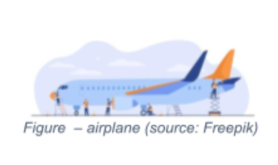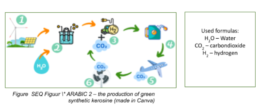Green on the Go
From CO2 in the air to fuel in the tank
-Hester Smit
On January 22, 2021, the first passenger plane partly flying on renewable fuel took off. Developed by Shell, the fuel was supposed to be a new green start in aviation. But according to critics, it was a start far too small start. After a long corona period, “normal life” seems to be slowly getting back on track, as Schiphol was already full of passengers in August 2021 and air traffic has already almost doubled compared to 2020. Due to the increase in the number of flights, we also see a huge increase in CO2 emissions in the air. These emissions contribute to the climate problem and need to be reduced urgently. Sustainable fuel can help, but whether it can solve all the problems… You will read the answer in this article.
The Netherlands likes to fly. A lot. Currently, aviation in the Netherlands uses kerosene as a fuel on a large scale. In 2018, almost four billion kg of kerosene was tanked; that’s enough to fill 1975 Olympic swimming pools. This kerosene is made from petroleum or natural gas and its combustion creates CO2. As a result, billions of kilograms of CO2 are emitted every year, making aviation the largest growing contributor to global warming within the transport sector in Europe.

Now you may be thinking “Oh well, I only travel by plane twice a year, it doesn’t matter that much, does it?” Take a look at the total emissions of a simple vacation flight. A return trip from the Netherlands to Greece easily produces about 600 kg of CO2 emissions per person. That amount of CO2 is equal to what could be saved by eating vegetarian for two years. In the climate crisis, every little bit helps, but one just a bit more than the other. Flying less or not at all would therefore help a lot, but with a population that loves flying so much, scientists like Joris Melkert prefer to work on a different solution: more sustainable flying. Melkert is education director and associate professor at the Faculty of Aerospace Engineering at Delft University of Technology and is committed to more sustainable aviation through his teaching and research. “It’s a wonderful idea to just fly less, but that’s just not going to happen I’m afraid. You can see that there is a one-to-one link between prosperity in a country and the speed at which people travel. If a middle class emerges, a country will simply fly more…”
Several parties, including Shell and TU Delft, have worked on a solution for this large-scale emissions problem within aviation in recent years. They have developed a fuel in which the CO2 content of the air will rise little to none. They convert the CO2 in the air into a liquid fuel for the tank. They call this fuel green synthetic kerosene – or sustainable, entirely man-made fuel. To make the green kerosene, you need three things: CO2, water and green energy. Figure 2 shows the entire process of production. Production begins with the generation of green energy; that is, energy generated by means of, for example, solar panels and wind turbines (step 1). With the energy generated, water is split into hydrogen and oxygen (step 2). The hydrogen (H2) reacts with CO2 from the air and a chemical reaction between the two substances forms liquid kerosene (step 3). The kerosene is refueled in the aircraft and the aircraft can take off (step 4). To fly, the kerosene must go through another chemical reaction, namely a combustion reaction. In this process, the kerosene reacts with oxygen from the air and CO2 is formed again (step 5). Next, the emitted CO2 is filtered out of the air with large fans that split the CO2 from other substances in the air (step 6). So the plane still emits CO2, but that gas is recycled by capturing it again and converting it into fuel. This makes for a CO2-neutral process.

Producing the green fuel is one thing, but using it is another. Only when using green energy is sustainable kerosene completely neutral in emissions, but this turns out to be a difficult task. In the Netherlands there is still too little green energy generated to provide enough electricity. Joris Melkert says that the CO2 loop in Figure 2 can now be closed for 85%. That means that 85% of the CO2 is recycled and only 15% forms additional CO2. “The neater you go through the process, the better you close the loop.” Another dilemma is that from a regulatory point of view, the sustainable kerosene must be mixed with the traditional kerosene. So far, the traditional fuel may be supplemented by up to 50% with the sustainable variant. Here the traditional kerosene provides a kind of lubrication for the mechanics. So the sustainable variant is actually too “clean” or pure. Melkert says, however, that this percentage can become much more. “In my research, up to 90% blending also goes just fine, but that amount of fuel is just not there yet.”
So with innovations like these, the sustainable revolution within aviation is not at a standstill, but it is not yet progressing very quickly either. By 2030, the government already requires 14% sustainable fuel to be added to aircraft. But this is little and still takes a very long time. What can we, the consumers, do to help? For now, the answer is still there: just fly less. “After all, the most economical fuel is the fuel you don’t use,” Melkert said. What about you? Are you waiting for the government to start imposing rules on the airlines or are you already willing to fly less?
Translated from Dutch

